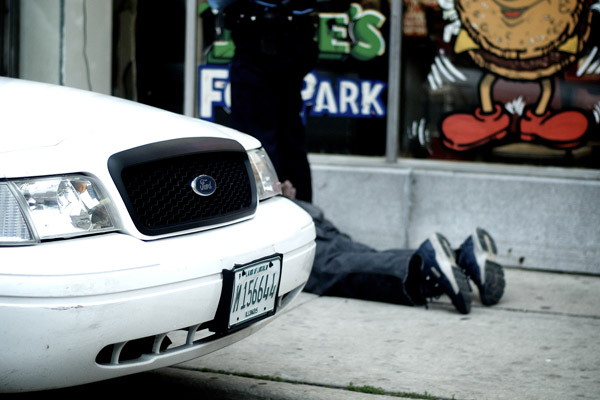
The other day Steven Vance, at his site Steven Can Plan, brought up a curious aspect of the city's Pedestrian Plan that you might have missed:
The 2011 Chicago Pedestrian Crash Analysis identified a strong correlation between community areas with high numbers of pedestrian crashes and community areas with high crime rates. Correlation does not indicate causation and further study is necessary to understand this relationship and the potential broader benefits of pedestrian safety improvements.
Vance finds the analysis reliable but problematic, which makes sense; that aspect of the plan proposes a study of the phenomenon. As the authors note, correlation isn't causation, and no one really understands why this is the case. But it's not an isolated phenomenon:
There are some good examples of work linking existing theory to the issue of road safety, in considering whether deviant road user behavior is just one aspect of a more general deviant tendency. Junger and Tremblay (1999), publishing in the criminological literature, have produced evidence that crime has a non-spurious positive association with road traffic accident involvement. Robert West and Marianne Junger collaborated (1999) to show that school children aged 7-15 who were in the top 25% of the distribution for problem behavior where three times more likely to be involved in a road traffic accident than were those in the lowest 25%.
In that post, I went into some of the research. But a new datapoint came up the other day that interested me. India has a real problem with traffic fatalities; every year six thousand people, in Mumbai alone, are killed by trains. That's six thousand people in a metro area of 20 million, the equivalent of three thousand people getting killed every year by trains in the Chicagoland area (in 2009, 565 people were killed in car carshes).
So the government's hired "behavior architects" to try to fix the problem (and lots of others) through behavioral economics. Here's how they see it:
They say that many antisocial behaviors in India can be traced to generations of scarcity—of resources and opportunities—and what they call an empathy gap. “We have this idea that whatever little space I get, whatever little opportunity comes my way, I need to make the most of it rather than giving it away, because for the longest time we’ve been used to limited resources,” Prasad says. This fear of scarcity contributes to the inconsiderate driving, line cutting, and pushing and shoving to board trains and buses before they’ve come to a complete stop that characterize any Mumbai commute.
Empathy's one part of it. But lots of people who grow up in privilege are not empathetic drivers. What else?
Improving road safety is especially challenging. Adams says there is an empathy gap on the roads and rails of less-developed countries. Less-affluent drivers, he says, generally have a more fatalistic attitude toward risk, while the affluent have a more cavalier attitude about the “chickens, pigs, and peasants” with whom they share the road.
That's John Adams, author of Risk. He has some interesting, controversial ideas about traffic and crashes—for instance, he's opposed to seat belt laws, because he says that making drivers safer merely encourages them to take more risks when driving; drivers will reach, within limits, their personally accepted level of risk. So it's unsurprising he'd view the problem through a behavioral lens, as opposed to one of infrastructure or
There's a lot of research into the relationship between risk, fatalism, and poverty, but most of it's centered around drug use and sexual behavior; the causual link between crime and "deviant road user behavior" is still a fresh topic, which is why I'm hopeful the study will go forward.
Photograph: davco9200 (CC by 2.0)



